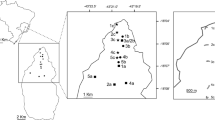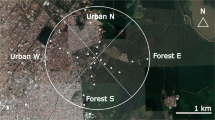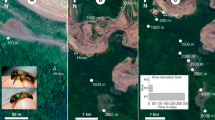Abstract
Male Neotropical orchid bees collect volatile chemicals from various sources in the environment in order to compose their characteristic perfume bouquets. Amongst other plants, over 600 species of orchids are exclusively pollinated by the bees during their quest for volatiles. Since the plants usually have a scattered distribution, it is assumed that orchid bees can transport the pollinaria across several kilometres due to their flight capabilities and a high dispersal potential. Until now, very long-range flight distances (up to 45 km) of male orchid bees have only been indirectly inferred from habitat requirements of orchids whose pollinaria were carried by captured males, whereas the distances established by direct measures (mark and recapture, radio telemetry) only span distances of up to around 6 km. The discrepancy between inferred and proven distances led us to readdress the question of dispersal ability of male orchid bees. In this study, we used tag, scratch and chemical marking of large numbers of bees to clarify two aspects: (1) the effect of moderate natural obstacles on dispersal and (2) the possibility of very long-range movements across a terrain lacking such obstacles. Our results suggest that a moderate natural obstacle (a valley separating opposite ridges) does not restrain orchid bee movements. Individual bees achieved extraordinary flight distances of more than 50 km across even terrain, extending the directly proven flight distances of male bees by more than an order of magnitude.






Similar content being viewed by others
References
Ackerman, J.D. (1983) Diversity and seasonality of male euglossine bees (Hymenoptera: Apidae) in Central Panamá. Ecology 64, 274–283
Ackerman, J.D. (1986) Coping with the epiphytic existence: pollination strategies. Selbyana 9, 52–60
Ackerman, J.D. (1989) Geographic and seasonal variation in fragrance choices and preferences of male euglossine bees. Biotropica 21, 340–347
Ackerman, J.D., Montalvo, A.M. (1985) Longevity of euglossine bees. Biotropica 17, 79–81
Ackerman, J.D., Mesler, M.R., Lu, K.L., Montalvo, A.M. (1982) Food-foraging behavior of male euglossini (Hymenoptera: Apidae): vagabonds or trapliners? Biotropica 14, 241–248
Andrade-Silva, A.C.R., Nascimento, F.S. (2012) Multifemale nests and social behavior in Euglossa melanotricha (Hymenoptera, Apidae, Euglossini). J. Hymenoptera Res. 26, 1–16
Armbruster, W.S., Webster, G.L. (1979) Pollination of two species of Dalechampia (Euphorbiaceae) in Mexico by euglossine bees. Biotropica 11, 278–283
Augusto, S.C., Garófalo, C.A. (2004) Nesting biology and social structure of Euglossa (Euglossa) townsendi Cockerell (Hymenoptera, Apidae, Euglossini). Insectes Soc. 51, 400–409
Cappellari, S.C., Harter-Marques, B. (2010) First report of scent collection by male orchid bees (Hymenoptera: Apidae: Euglossini) from terrestrial mushrooms. J. Kansas Entomol. Soc. 83, 264–266
Cranmer, L., McCollin, D., Ollerton, J. (2012) Landscape structure influences pollinator movements and directly affects plant reproductive success. Oikos 121, 562–568
Dodson, C.H., Hills, H.G., Adams, R.M., Williams, N.H. (1969) Biologically active compounds in orchid fragrances. Science 164, 1243–1249
Dressler, R.L. (1968) Observations on orchids and euglossine bees in Panama and Costa Rica. Rev. Biol. Trop. 15, 143–183
Dressler, R.L. (1982) Biology of the orchid bees (Euglossini). Annu. Rev. Ecol. Syst. 13, 373–394
Eltz, T., Whitten, M.W., Roubik, D.W., Linsenmair, K.E. (1999) Fragrance collection, storage and accumulation by individual male orchid bees. J. Chem. Ecol. 25, 157–176
Eltz, T., Roubik, D.W., Lunau, K. (2005) Experience-dependent choices ensure species-specific fragrance accumulation in male orchid bees. Behav. Ecol. Sociobiol. 59, 149–156
Eltz, T., Zimmermann, Y., Pfeiffer, C., Ramirez Pech, J., Twele, R., Francke, W., Quezada-Euan, J.J.G., Lunau, K. (2008) An olfactory shift is associated with male perfume differentiation and species divergence in orchid bees. Curr. Biol. 18, 1844–1848
Hartter, J., Lucas, C., Gaughan, A.E., Aranda, L.L. (2008) Detecting tropical dry forest succession in a shifting cultivation mosaic of the Yucatán peninsula, Mexico. Appl. Geogr. 28, 134–149
Janzen, D.H. (1971) Euglossine bees as long-distance pollinators of tropical plants. Science 171, 203–205
Janzen, D.H. (1981) Bee arrival at two Costa Rican female Catasetum orchid inflorescences, and a hypothesis on euglossine population structure. Oikos 36, 177–183
Kimsey, L.S. (1984) The behavioural and structural aspects of grooming and related activities in euglossine bees (Hymenoptera: Apidae). J. Zool. 204, 541–550
Kroodsma, D.E. (1975) Flight distances of male euglossine bees in orchid pollination. Biotropica 7, 71–72
Lihoreau, M., Chittka, L., Raine, N.E. (2010) Travel optimization by foraging bumblebees through readjustments of traplines after discovery of new feeding locations. Am. Nat. 176, 744–757
Pokorny, T., Hannibal, M., Quezada-Euan, J.J.G., Hedenström, E., Sjöberg, N., Bång, J., Eltz, T. (2013) Acquisition of species-specific perfume blends: influence of habitat-dependent compound availability on odour choices of male orchid bees (Euglossa spp.). Oecologia 172, 417–425
R Core Team (2013) R: A language and environment for statistical computing. R Foundation for Statistical Computing, Vienna, Austria. URL http://www.R-project.org/
Raw, A. (1989) The dispersal of euglossine bees between isolated patches of eastern Brazilian wet forest (Hymenoptera, Apidae). Rev. Bras. Entomol. 33, 103–107
Rocha Filho, L.C., Cerântola, N.C.M., Garófalo, C.A., Imperatriz-Fonseca, V.L., Lama, M.A. (2013) Genetic differentiation of the Euglossini (Hymenoptera, Apidae) populations on a mainland coastal plain and an island in southeastern Brazil. Genetica 141, 65–74
Roubik, D. W., Hanson, P. E. (2004) Orchid bees of tropical America. Instituto Nacional de Biodiversidad (INBio)
Silva, M.D., Andrade-Silva, A.C.R., Silva, M. (2011) Long-term male aggregations of Euglossa melanotricha Moure (Hymenoptera: Apidae) on fern fronds Serpocaulon triseriale (Pteridophyta: Polypodiaceae). Neotrop. Entomol. 40, 548–552
Skov, C., Wiley, J. (2005) Establishment of the neotropical orchid bee Euglossa viridissima (Hymenoptera: Apidae) in Florida. Fla. Entomol. 88, 225–227
Tonhasca, A.J., Albuquerque, G.S., Blackmer, J.L. (2003) Dispersal of euglossine bees between fragments of the Brazilian Atlantic Forest. J. Trop. Ecol. 19, 99–102
Vogel, S. (1966) Parfümsammelnde Bienen als Bestäuber von Orchidaceen und Gloxinia. Österr. Bot. Zeitschrift 113, 302–361
Whitten, M.W., Young, A.M., Stern, D.L. (1993) Nonfloral sources of chemicals that attract male euglossine bees (Apidae: Euglossini). J. Chem. Ecol. 19, 3017–3027
Wikelski, M., Moxley, J., Eaton-Mordas, A., López-Uribe, M.M., Holland, R., Moskowitz, D., Roubik, D.W., Kays, R. (2010) Large-range movements of neotropical orchid bees observed via radio telemetry. PLoS ONE 5, e10738
Williams, N.H., Dodson, C.H. (1972) Selective attraction of male euglossine bees to orchid floral fragrances and its importance in long distance pollen flow. Evolution 26, 84–95
Williams, N.H., Whitten, M.W. (1983) Orchid floral fragrances and male euglossine bees: methods and advances in the last sequidecade. Biol. Bull. 164, 355–395
Zimmermann, Y., Ramírez, S.R., Eltz, T. (2009) Chemical niche differentiation among sympatric species of orchid bees. Ecology 90, 2994–3008
Zimmermann, Y., Schorkopf, D.L.P., Moritz, R.F.A., Pemberton, R.W., Quezada-Euan, J.J.G., Eltz, T. (2011) Population genetic structure of orchid bees (Euglossini) in anthropogenically altered landscapes. Conserv. Genet. 12, 1183–1194
Acknowledgments
M. Hannibal, N. Blumreiter, I. Vogler, L. Roßmannek, H. Hausmann, J. Henske, C. Castillo, A. Durán Yáñez and R. Guillermo helped with bee capture and marking. Funding was provided by the German Science Foundation (EL249/6) and the PROALMEX program (120989) of the German Academic Exchange Service and the Consejo Nacional de Ciencia y Tecnología (103341) to T.E. and J.Q.E. We want to thank two anonymous reviewers for contributing to improve the manuscript.
Author information
Authors and Affiliations
Corresponding author
Additional information
Manuscript editor: James Nieh
Capacité de dispersion des mâles d’abeilles à orchidée et preuve directe de vols de longue distance
Euglossine / pollinisation / orchidée / flux génique / génétique des populations / déplacement longue distance
Ausbreitungspotential männlicher Prachtbienen und direkte Belege für Flüge über große Entfernungen
Euglossini / Orchideenbestäubung / weite Ausbreitungsdistanz / Genfluss / Populationsgenetik
Rights and permissions
About this article
Cite this article
Pokorny, T., Loose, D., Dyker, G. et al. Dispersal ability of male orchid bees and direct evidence for long-range flights. Apidologie 46, 224–237 (2015). https://doi.org/10.1007/s13592-014-0317-y
Received:
Revised:
Accepted:
Published:
Issue Date:
DOI: https://doi.org/10.1007/s13592-014-0317-y




